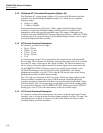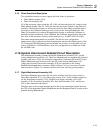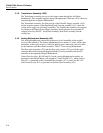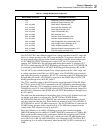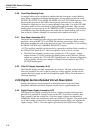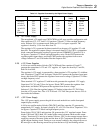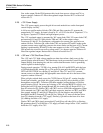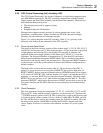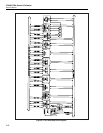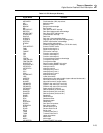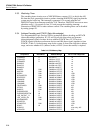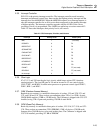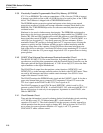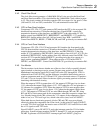
5700A/5720A Series II Calibrator
Service Manual
2-20
flow to the output. Diode CR16 protects this circuit from reverse voltage and C4 is a
bypass capacitor. Inductor L2 filters the regulated output. Resistor R13 is a bleed-off
resistor for C3.
2-28. +75V Power Supply
The +75V power supply powers the grid drivers and anode drivers on the front panel
control display circuitry.
A full-wave rectifier made of diodes CR1-CR4 and filter capacitor C1 generate the
unregulated +75V supply. Its input is fused by F1, a 0.315A slow-blow. Capacitor C17 is
for bypass. Capacitor C24 filters out high frequency noise.
The +75V regulated output is generated by 36V zener diode VR6, 39V zener diode VR7,
and transistors Q1 and Q3. Zener diodes VR6 and VR7 set the output voltage.
Transistors Q1 and Q3, in a Darlington configuration for current gain, are used as an
emitter follower. Transistor Q4, zener diode VR5, and resistors R2 and R3 make up the
constant current source supplying current to the zener diodes and the base of Q3. Current
limiting is performed by R1 and Q2 in the same manner as in the +35V supply. Diode
CR8 protects the circuit from reverse voltage and C2 is a bypass capacitor. Inductor L1
filters the regulated output. Resistor R6 is a bleed-off resistor for C1.
2-29. +35V and +75V Shut-Down Circuit
The +35V and +75V high voltage supplies are shut down when a fault occurs in the
control display refresh circuitry. This shut-down circuit prevents the Control Display and
Output Display from burning out, and also verifies that the master clock is generating
control signals for both displays.
During normal operation, 75VSD is low, turning Q10 off. Line RESETL pulls the base
of Q9 high through R9, turning Q9 on. This action in turn pulls the junctions of CR31-
CR32 and CR33-CR34 low, turning Q7 and Q8 off. The +75V and +35V constant-
current sources can then supply the appropriate zener diodes and drive the bases of the
respective emitter followers.
When a display refresh fault occurs, the 75VSD line on P41 pin 5C, coming from the
Front Panel assembly, goes high. this signal, pulled up by R4, drives the base of Q10
through base resistor R11. Transistor Q10 then saturates, pulling the base of Q9 near
ground, turning Q9 off. On power-up or during a CPU reset, the RESETL signal is low,
pulling the base of Q9 near ground through R9, also turning Q9 off. Resistor R12 is a
turn-off resistor for Q9. Diodes CR31 and CR33 are in a wired-OR configuration. When
Q9 is saturated (on), CR31 and CR33 pull their respective junctions to CR32 and CR34
near ground, turning Q7 and Q8 off. When Q9 is off, the junctions are pulled high
through R8 and R10, saturating Q7 and Q8 (on). When on, Q7 removes the base drive
from Q3, shutting down the +75V supply. Similarly, Q8 removes the base drive from
Q5, shutting down the +35V supply.
Diodes CR32 and CR34 simply ensure that Q7 and Q8 are off when Q9 is on. Resistor
R8 guarantees that Q7 will hold the +75V supply off until it drops below 15.6V, and R10
holds the +35V supply off to 7.8V.



